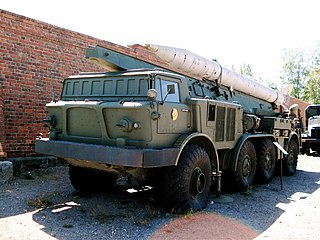 W
WThe 9K52 Luna-M is a Soviet short-range artillery rocket system. It fires unguided and spin-stabilized 9M21 rockets.
 W
WThe 10 cm Nebelwerfer 35 was a heavy mortar used by Germany during World War II. Much like the American M2 4.2 inch mortar it was intended to deliver chemical munitions, such as gas and smoke shells. Unlike the American weapon it appears to have had an ordinary high-explosive shell from the beginning. It was of conventional design, and was virtually a scaled-up 8 cm GrW 34. It broke down into the standard three loads for transport. The tube weighed 31.7 kg (70 lb), the baseplate 36.3 kg (80 lb) and the bipod 32.2 kg (71 lb). Each could be man-packed for some distance, but small handcarts were issued for longer distances. Each mortar squad consisted of a squad leader, three gunners and three ammunition bearers.
 W
WThe 10 cm Nebelwerfer 40 was a heavy mortar used by Germany during the Second World War. Much like the American M2 4.2 inch mortar it was intended to deliver chemical munitions, such as gas and smoke shells, as well as ordinary high-explosive shells. It was derived from Rheinmetall's Nebelwerfer 51 and 52 prototypes of the late Thirties which were attempts to develop a more accurate and longer-ranged mortar than the 10 cm Nebelwerfer 35. The NbW 40 is one of the better examples of German overengineering since it fired a slightly heavier bomb over twice as far as the NbW 35, but weighed almost eight times more than the earlier model.
 W
WThe Soviet 107mm M1938 mortar was a scaled-down version of the 120mm M1938 mortar intended for use by mountain troops and light enough to be towed by animals on a trolley.
 W
WAl Hussein or al-Husayn is the designation of an Iraqi short-range ballistic missile. The missile was the result of upgrading the Soviet made Scud in order to achieve a longer range. The weapon was widely used by the Iraqi Army during the Iran–Iraq War and the Gulf War of 1991.
 W
WA barrel bomb is an improvised unguided bomb, sometimes described as a flying IED. They are typically made from a large barrel-shaped metal container that has been filled with high explosives, possibly shrapnel, oil or chemicals as well, and then dropped from a helicopter or airplane. Due to the large amount of explosives, their poor accuracy and indiscriminate use in populated civilian areas, the resulting detonations have been devastating. Critics have characterised them as weapons of terror and illegal under international conventions.
 W
WThe BM-14, is a Soviet-made 140mm multiple launch rocket system (MLRS), normally mounted on a truck.
 W
WThe BM-21 "Grad" is a Soviet truck-mounted 122 mm multiple rocket launcher. The weapons system and the M-21OF rocket were first developed in the early 1960s, and saw their first combat use in March 1969 during the Sino-Soviet border conflict. BM stands for boyevaya mashina, and the nickname grad means "hail". The complete system with the BM-21 launch vehicle and the M-21OF rocket is designated as the M-21 field-rocket system. The complete system is more commonly known as a Grad multiple rocket launcher system. In NATO countries the system was initially known as M1964. Several other countries have copied the Grad or have developed similar systems.
 W
WThe Livens Projector was a simple mortar-like weapon that could throw large drums filled with flammable or toxic chemicals.
 W
WThe M1 mortar is an American 81 millimeter caliber mortar. It was based on the French Brandt mortar. The M1 mortar was used from World War II until the 1950s when it was replaced by the lighter and longer ranged M29 mortar.
 W
WThe M2 4.2-inch mortar was a U.S. rifled 4.2-inch (107 mm) mortar used during the Second World War and the Korean War. It entered service in 1943. It was nicknamed the "Goon Gun" or the "Four-Deuce". In 1951 it began to be phased out in favor of the M30 mortar of the same caliber.
 W
WThe M2 Mortar is a 60 millimeter smoothbore, muzzle-loading, high-angle-of-fire weapon used by U.S. forces in World War II, the Korean War, and the Vietnam War for light infantry support.
 W
WThe M10 smoke tank, also known as Smoke Curtain Installation, was an aircraft under wing tank used by the United States Army Air Forces to lay smoke screens or dispense chemical weapons such as tear gas. The tanks held a maximum of 30 gallons, and weighed, when full 588 pounds and could lay a smoke screen about 2,000 feet long.
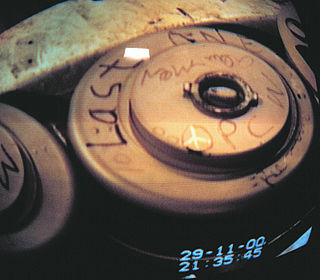 W
WThe M23 is a United States steel cased chemical landmine. The mine was developed in the late 1950s and early 1960s, and approximately 100,000 units were produced. The U.S. completed its destruction of its stock at the Umatilla Chemical Depot in 2008 and the Johnston Atoll Chemical Agent Disposal System in 2000.
 W
WThe M30 106.7 mm heavy mortar is an American rifled, muzzle-loading, high-angle-of-fire weapon used for long-range indirect fire support to infantry units.
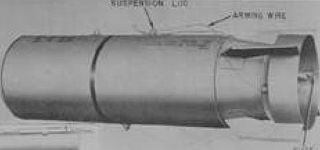 W
WThe M34 cluster bomb was the first mass-produced United States Army weapon meant to deliver the chemical agent sarin (GB). A large stockpile of M34s was destroyed between 1973 and 1976.
 W
WThe M43 BZ cluster bomb, or simply M43 cluster bomb, was a U.S. chemical cluster bomb intended to deliver the incapacitating agent known as BZ. The weapon was produced in the early 1960s and all stocks of U.S. BZ were destroyed by 1989.
 W
WThe M44 generator cluster was an American chemical cluster bomb designed to deliver the incapacitating agent BZ. It was first mass-produced in 1962 and all stocks of the weapons were destroyed by 1989.
 W
WThe M55 rocket was a chemical weapon developed by the United States in the 1950s. The United States Army produced both Sarin and VX unitary warheads for the M55.
 W
WThe Flame Thrower Tank M67 is an American medium flame tank that was briefly used by the U.S. Army, and later by the U.S. Marine Corps during the Vietnam War. It was the last flamethrower tank used in American military service.
 W
WThe M134 bomblet was a U.S. chemical sub-munition designed for use in the Honest John rocket during the 1950s. The weapon was never mass-produced and was supplanted in 1964 by an improved design, the M139.
 W
WThe M139 bomblet was a U.S. sub-munition designed for use in warheads as a chemical cluster munition. Each spherical bomblet held 590 grams (1.3 lb) of sarin nerve agent.
 W
WThe M687 is an American 155 mm binary sarin chemical weapon artillery shell. The design was standardized in 1976 and production began on December 16, 1987 at Pine Bluff Arsenal, Pine Bluff, Arkansas. Production was halted three years later, following a June 1990 chemical weapon destruction treaty with Russia, and the dismantling of existing stocks began in November 1997 at Hawthorne Army Depot, Nevada. America's remaining stocks were stored at the Deseret Chemical Depot, Utah, and the Umatilla Chemical Depot.
 W
WThe MC-1 bomb was the first U.S. non-clustered air-dropped chemical munition. The 750-pound (340 kg) MC-1 was first produced in 1959 and carried the nerve agent sarin.
 W
WThe MGM-5 Corporal missile was a nuclear-armed tactical surface-to-surface missile. It was the first guided weapon authorized by the United States to carry a nuclear warhead. A guided tactical ballistic missile, the Corporal could deliver either a nuclear fission, high-explosive, fragmentation or chemical warhead up to a range of 75 nautical miles (139 km).
 W
WThe MGR-1 Honest John rocket was the first nuclear-capable surface-to-surface rocket in the United States arsenal. Originally designated Artillery Rocket XM31, the first unit was tested on 29 June 1951, with the first production rounds delivered in January 1953. Its designation was changed to M31 in September 1953. The first Army units received their rockets by year's end and Honest John battalions were deployed in Europe in early 1954. Alternatively, the rocket was capable of carrying an ordinary high-explosive warhead weighing 1,500 pounds (680 kg).
 W
WThe Ordnance ML 4.2-inch mortar was a heavy mortar used by the British Army during and after World War II.
 W
WOTR-21 Tochka is a Soviet tactical ballistic missile. Its GRAU designation is 9K79; its NATO reporting name is SS-21 Scarab. It is transported in a 9P129 vehicle and raised prior to launch. It uses an inertial guidance system.
 W
WThe R-11 Zemlya, GRAU index 8A61 was a Soviet tactical ballistic missile. It is also known by its NATO reporting name SS-1b Scud-A. It was the first of several similar Soviet missiles to be given the reporting name Scud. Variant R-11M was accepted into service, with GRAU index 9K51.
 W
WThe R-17 Elbrus, GRAU index 9K72 is a tactical ballistic missile, initially developed by the Soviet Union. It is also known by its NATO reporting name SS-1C Scud-B. It is one of several Soviet missiles to carry the reporting name Scud; the most prolifically launched of the series, with a production run estimated at 7,000 (1960–1987). Also designated R-300 during the 1970s, the R-17 was derived from the R-11 Zemlya. It has been operated by 32 countries and manufactured in four countries outside the Soviet Union. It is still in service with some. Hwasong-5 in North Korea.
 W
WA Scud missile is one of a series of tactical ballistic missiles developed by the Soviet Union during the Cold War. It was exported widely to both Second and Third World countries. The term comes from the NATO reporting name attached to the missile by Western intelligence agencies. The Russian names for the missile are the R-11, and the R-17 Elbrus. The name Scud has been widely used to refer to these missiles and the wide variety of derivative variants developed in other countries based on the Soviet design.
 W
WMore than 50 different modifications and experimental vehicles based on the T-26 light infantry tank chassis were developed in the USSR in the 1930s, with 23 modifications going into series production. The majority were armoured combat vehicles: flame tanks, artillery tractors, radio-controlled tanks (teletanks), military engineering vehicles, self-propelled guns and armoured personnel carriers. They were developed at the Leningrad Factory of Experimental Mechanical Engineering by talented Soviet engineers P.N. Syachentov, S.A. Ginzburg, L.S. Troyanov, N.V. Tseits, B.A. Andryhevich, M.P. Zigel and others. Many Soviet tank engineers were declared "enemies of the nation" and repressed during Stalin's Great Purge from the middle of the 1930s. As a result, work on self-propelled guns and armoured carriers ceased in the USSR during that time. T-26 light tanks were also modified into armoured combat vehicles in the field during wartime.
 W
WThe M3 Stuart, officially Light Tank, M3, was an American light tank of World War II. An improved version entered service as M5. It was supplied to British and other Commonwealth forces under lend-lease prior to the entry of the U.S. into the war. Thereafter, it was used by U.S. and Allied forces until the end of the war.
 W
WTeletanks were a series of wireless remotely controlled unmanned tanks produced in the Soviet Union in the 1930s and early 1940s so as to reduce combat risk to soldiers. They saw their first combat use in the Winter War, at the start of World War II. A teletank is controlled by radio from a control tank at a distance of 500–1,500 metres, the two constituting a telemechanical group. Teletanks were used by the Soviet Red Army in the Winter War, fielding at least two teletank battalions at the beginning of the World War II on Eastern Front.
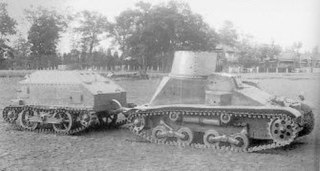 W
WThe Type 94 Disinfecting Vehicle and Type 94 Gas Scattering Vehicle was a variant of the Type 94 tankette adapted to chemical warfare by the Imperial Japanese Army. The Type 94 Disinfecting Vehicle and Type 94 Gas Scattering Vehicle were configured as an independent mobile liquid dissemination chemical vehicle with respective mobile disinfecting anti-chemical agents vehicle for support to Japanese chemical infantry units in combat.
 W
WThe West Spring Gun was a bomb-throwing catapult used by British, Canadian and Australian forces during World War I. It was designed to throw a hand grenade in a high trajectory into enemy trenches.
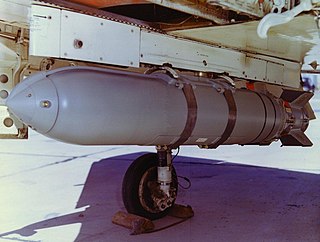 W
WThe Weteye bomb was a U.S. chemical weapon designed for the U.S. Navy and meant to deliver the nerve agent sarin. The Weteye held 160 kg (350 lb) of liquid sarin and was officially known as the Mk 116. Stockpiles of Weteyes were transferred to Utah in the 1980s amidst controversy and protest.